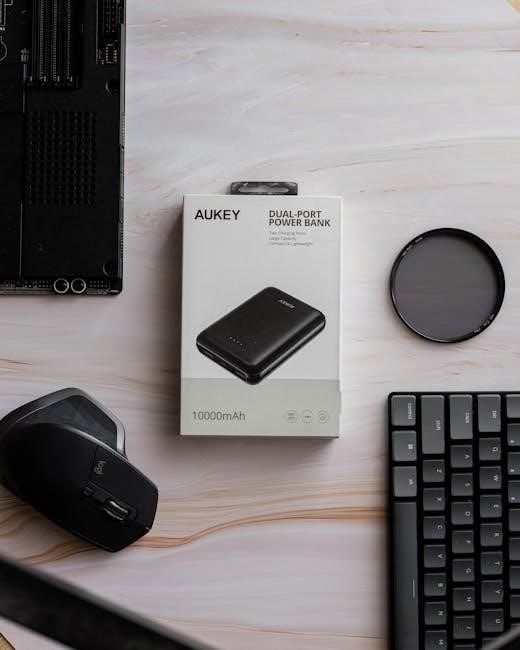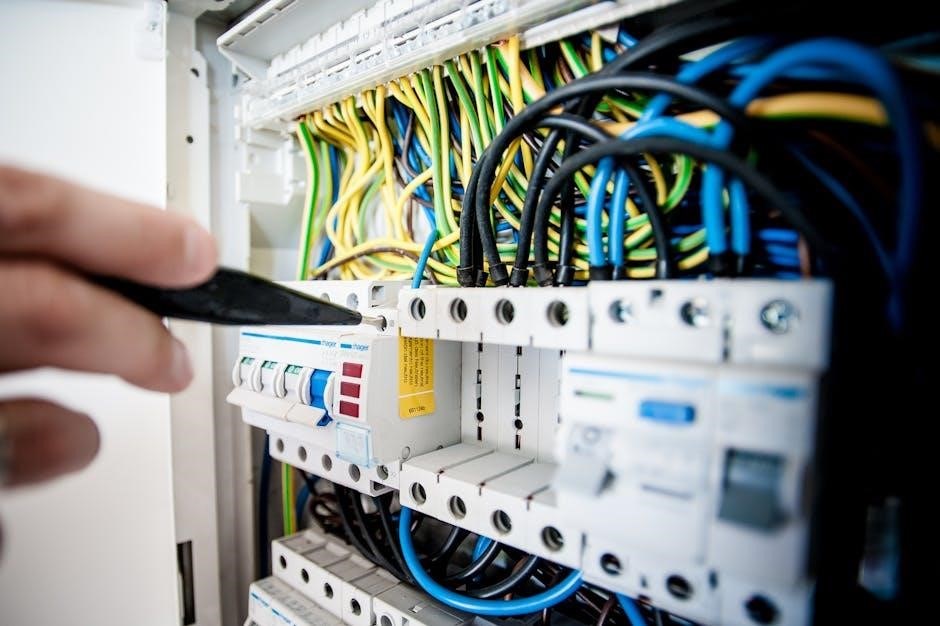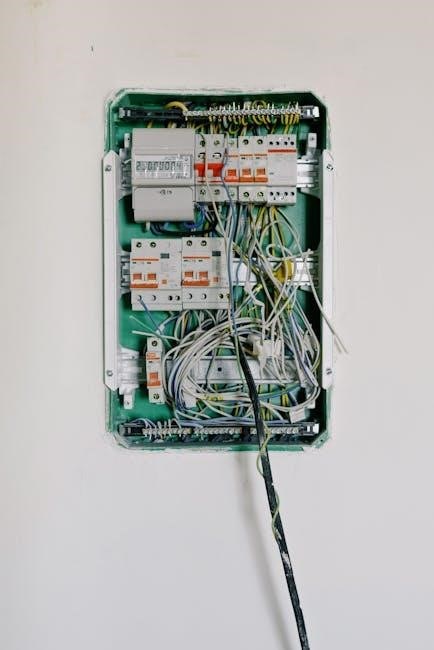Drivers must obey instructions from authorities like police, traffic officers, and security guards to ensure safety, maintain order, and comply with legal requirements while driving.
1.1 Overview of the Importance of Following Instructions
Following instructions from authorities is crucial for maintaining road safety, reducing congestion, and ensuring legal compliance. Drivers must obey directions from police, traffic officers, and security guards to prevent accidents and avoid penalties. Ignoring these instructions can lead to fines, license suspension, or even criminal charges. Compliance ensures smooth traffic flow and protects all road users. By adhering to instructions, drivers contribute to a safer and more orderly transportation system, benefiting everyone on the road. This responsibility is shared among all drivers, emphasizing the importance of collective obedience for public safety and legal adherence.
1.2 Brief Explanation of Key Authorities Drivers Must Obey
Drivers are required to obey instructions from various authorities to ensure safe and lawful driving. Police officers enforce traffic laws and provide critical directions during emergencies or accidents. Traffic control officers manage flow at intersections and construction zones, while security guards direct vehicles in parking lots and private properties. Additionally, drivers must follow flaggers in construction areas and emergency responders like firefighters and paramedics. Even other drivers, such as those with broken-down vehicles, may signal for safety. Compliance with these authorities is essential for maintaining order, preventing accidents, and adhering to legal standards on the road.
Police Officers
Police officers enforce traffic laws, provide critical directions during emergencies, and ensure road safety. Drivers must obey their instructions to avoid legal consequences and maintain order on roads.
2.1 The Role of Police in Traffic Control
Police officers play a crucial role in maintaining traffic order and safety. They are authorized to direct drivers, investigate accidents, and enforce traffic laws. Drivers must obey police instructions to ensure smooth traffic flow and prevent hazards. Police may stop vehicles, redirect traffic during emergencies, or control pedestrian movements. Ignoring their directives can lead to legal consequences, including fines or penalties. Their presence is essential in high-risk situations, such as accidents or construction zones, where clear guidance is necessary to protect everyone involved. Compliance with police instructions is vital for public safety and legal adherence.

2.2 Legal Consequences of Disobeying Police Instructions
Disobeying police instructions while driving can result in severe legal consequences. Drivers who fail to comply may face fines, penalties, or even license suspension. In some cases, criminal charges can be filed, especially if the disobedience leads to accidents or endangers others. Police officers have the authority to enforce traffic laws, and ignoring their directives is considered a serious offense. Non-compliance can also lead to increased insurance rates and a permanent record. It is essential for drivers to understand that obeying police instructions is not only a legal requirement but also a matter of road safety and responsibility.
2.3 Examples of Police Instructions Drivers Must Follow
Drivers must adhere to various police instructions, such as stopping at checkpoints, pulling over when signaled, or following hand gestures to merge lanes. Police may direct traffic flow during accidents or construction, and ignoring these commands can lead to fines or legal action. Additionally, drivers are required to comply with orders to reduce speed or change direction to ensure safety. Failure to obey can result in penalties, including license suspension or increased insurance rates. Police instructions are essential for maintaining order and preventing accidents on the road.
Traffic Control Officers
Traffic control officers direct drivers to ensure safe flow, manage congestion, and maintain order, with legal consequences for disobedience, emphasizing safety and compliance on the road.
3.1 Duties of Traffic Control Officers
Traffic control officers play a crucial role in maintaining road safety and order. Their primary duties include directing traffic flow, managing traffic signals, and ensuring pedestrians and vehicles move safely. They often work at intersections, construction zones, or accident sites to prevent congestion and accidents. Additionally, they provide clear instructions to drivers, such as when to stop, go, or change lanes. Their presence helps reduce chaos and ensures smooth traffic movement, making their instructions essential for drivers to follow to avoid hazards and comply with traffic laws.
3.2 Importance of Obeying Traffic Control Signals
Obeying traffic control signals is crucial for maintaining road safety and order. These signals, including lights, signs, and markings, guide drivers to prevent accidents and ensure smooth traffic flow. Disregarding them can lead to collisions, fines, or legal action. Authorities like police and traffic officers enforce these rules to protect all road users. By following signals, drivers contribute to a safer environment and avoid potential legal consequences. Compliance is essential for collective responsibility and adherence to traffic laws, ensuring everyone reaches their destination safely.
3.3 Real-Life Scenarios Where Traffic Officers Provide Critical Instructions
Traffic officers often provide crucial guidance during emergencies, such as directing drivers around flooded roads or managing accident scenes. In construction zones, they ensure safe passage through lane closures. During events like parades or protests, officers coordinate traffic flow to prevent congestion. Their instructions are vital for maintaining order and safety in dynamic situations. Ignoring these directives can lead to accidents or legal consequences, emphasizing the importance of compliance. Real-life examples include officers guiding vehicles during evacuations or signaling merges in high-traffic areas, showcasing their essential role in keeping roads safe and efficient.

Security Guards
Security guards direct traffic in parking lots and private properties, ensuring safety and order. Drivers must obey their instructions to avoid legal consequences and maintain smooth operations.
4.1 Role of Security Guards in Parking Lots and Private Properties
Security guards play a crucial role in managing traffic flow and ensuring safety in parking lots and private properties. They are authorized to direct drivers, control access, and enforce rules to prevent accidents and unauthorized entry. Their instructions are essential for maintaining order and protecting both vehicles and pedestrians. Drivers must obey their directions, such as stopping, yielding, or parking in designated areas. Ignoring security guards’ instructions can lead to legal consequences, as they are empowered to take action to maintain safety and security on private premises. Their role is vital for smooth operations in controlled environments.

4.2 Legal Authority of Security Guards in Directing Traffic

Security guards often have legal authority to direct traffic on private properties, such as parking lots and construction zones. Their instructions are enforceable under property laws, requiring drivers to comply. Guards may stop vehicles, control pedestrian access, and manage traffic flow to ensure safety. Ignoring their directives can result in legal action, including fines or trespassing charges. This authority is recognized by law, making it mandatory for drivers to follow their instructions to maintain order and prevent accidents in controlled environments. Their role is essential for safeguarding both people and property effectively.
4.3 Consequences of Ignoring Security Guard Instructions
Ignoring security guard instructions can lead to severe consequences, including fines, legal action, and potential arrest. Drivers who disregard directives may face charges of trespassing or reckless endangerment. In private properties, guards can detain vehicles or individuals for non-compliance. Additionally, failure to follow instructions may result in liability for accidents or damages caused. Legal penalties vary by jurisdiction but often include financial penalties and increased insurance costs. Compliance is crucial to avoid legal repercussions and ensure safety in controlled environments, such as parking lots or construction zones, where security guards play a critical role in maintaining order and preventing incidents.
Flaggers
Flaggers are essential in construction zones, directing traffic to ensure safety and order. Drivers must obey their signals to prevent accidents and comply with legal requirements.
5.1 The Role of Flaggers in Construction Zones
Flaggers play a critical role in construction zones by directing traffic safely around work areas. They use signs, signals, and gestures to guide drivers, ensuring smooth flow and preventing accidents. Their instructions are essential to maintain order and protect both workers and motorists. Ignoring flaggers’ directions can lead to dangerous situations, making their role indispensable for on-site safety. By following their guidance, drivers help minimize disruptions and contribute to the efficient completion of construction projects. Flaggers’ visibility and clear communication are key to maintaining safety in dynamic and potentially hazardous environments.
5.2 Importance of Following Flagger Instructions for Safety
Following flagger instructions is crucial for ensuring safety in construction zones. Flaggers are trained to manage traffic flow, preventing accidents and protecting workers. Disregarding their signals can lead to collisions, injuries, or even fatalities. By obeying flaggers, drivers help maintain a safe environment for everyone. Their directions are designed to navigate through hazardous areas safely, reducing risks associated with construction activities. Compliance with flagger instructions not only prevents legal consequences but also upholds the responsibility of all road users to prioritize safety and respect the rules in place to protect lives and infrastructure.
5.3 Legal Implications of Disobeying Flaggers
Disobeying flaggers can result in severe legal consequences. Drivers who ignore flagger instructions may face fines, penalties, and even license suspension. In many jurisdictions, flaggers are authorized to enforce traffic laws, making their directions legally binding. Violations can be treated similarly to disobeying police or traffic signals. Additionally, reckless disregard for flagger instructions may lead to criminal charges, especially if it endangers others. Legal implications underscore the importance of compliance, ensuring both personal and collective safety on the road. Ignoring flaggers not only risks legal action but also undermines efforts to maintain safe construction zones.

Emergency Responders
Emergency responders, including firefighters and paramedics, direct traffic during crises. Drivers must obey their instructions to ensure safety and prevent accidents, avoiding legal consequences.
6.1 Firefighters and Paramedics Directing Traffic
Firefighters and paramedics often direct traffic during emergencies, such as accidents or medical situations, to ensure safety and maintain order. Drivers must obey their instructions to prevent further hazards and allow emergency services to operate effectively. These professionals have the authority to control traffic flow, and disregarding their directions can lead to dangerous situations. Their role is critical in managing chaotic scenes and protecting both the public and themselves. Compliance with their guidance is essential for efficient crisis management and minimizing risks. Failure to follow their instructions can result in legal consequences and jeopardize overall safety. Their expertise ensures orderly traffic control in critical moments.

6.2 Consequences of Not Obeying Emergency Responders
Disobeying emergency responders, such as firefighters or paramedics, can lead to severe legal and safety repercussions. Drivers who ignore their instructions may face fines, penalties, or even criminal charges, especially if their actions endanger others. Emergency responders are authorized to direct traffic in critical situations, and failing to comply can result in accidents or hinder rescue operations. Additionally, such disobedience may lead to license suspension or revocation, depending on the severity of the incident. It is crucial to recognize their authority and follow their guidance to ensure public safety and avoid legal consequences. Compliance is essential in emergency scenarios to prevent further risks.
6.3 Examples of Emergency Situations Requiring Driver Compliance
Emergency situations, such as fires, medical emergencies, or natural disasters, often require immediate driver compliance with responders’ instructions. For instance, during a flood, authorities may direct drivers to evacuate or avoid certain routes to prevent accidents. Similarly, in fire scenarios, firefighters may signal drivers to stop or detour to allow fire trucks to pass. Disregarding these instructions can hinder rescue operations and endanger lives. Compliance ensures smooth emergency response, prevents accidents, and safeguards public safety. Drivers must remain vigilant and follow directives promptly in such critical moments to support effective crisis management and protect themselves and others.
Other Drivers
Drivers must obey instructions from other drivers, especially those with broken-down vehicles or using hand signals, to ensure safety and legal compliance on the road.
7.1 The Role of Drivers with Broken-Down Vehicles
Drivers with broken-down vehicles play a crucial role in maintaining road safety by using hand signals or hazard lights to alert other drivers. They must communicate their situation clearly to prevent accidents and ensure smooth traffic flow. Their actions, such as moving to a safe location or signaling for help, are essential for protecting themselves and others. By following proper protocols, they contribute to overall road safety and reduce the risk of secondary incidents. Their responsibility extends to minimizing disruptions while awaiting assistance, ensuring the safety of all road users. This role underscores the importance of driver cooperation and awareness.
7.2 Importance of Following Hand Signals from Other Drivers
Following hand signals from other drivers is vital for maintaining road safety and preventing accidents. These signals often indicate intentions, such as changing lanes or slowing down, helping other drivers anticipate actions. Ignoring them can lead to confusion and collisions. Hand signals are particularly important in situations where vehicles are broken down or when communication is limited. By adhering to these signals, drivers demonstrate mutual respect and cooperation, fostering a safer and more orderly traffic environment. This practice is a cornerstone of responsible driving and ensures the well-being of all road users.
7.3 Legal and Safety Implications of Ignoring Fellow Drivers
Ignoring hand signals or instructions from fellow drivers can lead to severe legal and safety consequences. Legally, drivers who disregard such signals may face fines or penalties for reckless driving. Safety-wise, this negligence can result in accidents, injuries, or even fatalities. It undermines the collective responsibility for road safety, creating chaos and unpredictability. Courts often hold negligent drivers accountable, emphasizing the importance of mutual cooperation. Thus, obeying fellow drivers’ signals is not just courteous but legally and morally essential for maintaining a safe and orderly traffic flow.

Legal Consequences of Disobedience
Disobeying instructions from authorities can result in fines, penalties, license suspension, or criminal charges, emphasizing the importance of compliance for legal and safety reasons.
8.1 Fines and Penalties for Ignoring Instructions
Ignoring instructions from authorities can result in fines, penalties, and legal consequences. Drivers who disobey police, traffic officers, or security guards may face monetary fines, points on their license, or even vehicle impoundment. In severe cases, repeated offenses can lead to license suspension or revocation. Additionally, failure to comply with emergency responders or flaggers may result in heightened penalties, reflecting the severity of the disobedience. These measures aim to enforce compliance and maintain road safety, ensuring the well-being of all road users. Penalties vary by jurisdiction but consistently emphasize the importance of following directives.
8.2 Potential License Suspension or Revocation
Repeated or severe instances of disobeying instructions from authorities can lead to license suspension or revocation. Drivers who consistently ignore directives from police, traffic officers, or emergency responders face heightened penalties. License suspension temporarily withdraws driving privileges, while revocation permanently removes them, requiring reinstatement. Such actions are taken to ensure accountability and road safety. Authorities enforce these measures to address reckless behavior, emphasizing the importance of compliance. License penalties vary by jurisdiction but serve as a strong deterrent against ignoring lawful instructions, protecting both drivers and the public from potential hazards. Compliance is essential to avoid such severe consequences.
8.3 Criminal Charges in Severe Cases
In severe cases, drivers who disregard instructions from authorities may face criminal charges. This includes situations where non-compliance leads to accidents, injuries, or significant disruptions. Law enforcement can pursue charges such as reckless endangerment or obstructing justice. Criminal charges often result in fines, probation, or even imprisonment. Courts treat such offenses seriously, especially when public safety is compromised. Drivers must understand that ignoring directives can escalate beyond traffic violations, leading to long-term legal consequences. Compliance is crucial to avoid severe penalties and ensure the safety of all road users. Authorities enforce these measures to maintain order and accountability on the roads.

Safety Implications
Obeying instructions from authorities ensures accident prevention, reduces congestion, and promotes collective responsibility for road safety, protecting all users and maintaining orderly traffic flow effectively always.
9.1 How Following Instructions Prevents Accidents
Obeying instructions from authorities significantly reduces the risk of accidents by ensuring coordinated movement on the road. When drivers follow directions from police, traffic officers, or flaggers, it minimizes confusion and unpredictability, allowing everyone to anticipate actions safely. For instance, stopping at a police officer’s signal or adhering to a flagger’s guidance in construction zones prevents sudden stops or lane changes that could lead to collisions. Compliance also ensures smooth traffic flow, reducing congestion that often leads to accidents. By prioritizing obedience, drivers contribute to a safer environment for all road users, demonstrating collective responsibility for accident prevention and overall safety.
9.2 The Role of Obedience in Reducing Traffic Congestion
Obedience to traffic instructions plays a crucial role in reducing congestion by ensuring smooth and efficient movement of vehicles. When drivers follow directions from authorities, such as police officers or traffic control officers, it prevents unnecessary stops and lane blockages. For example, obeying signals to merge lanes or yield to emergency vehicles helps maintain consistent traffic flow. This cooperation minimizes bottlenecks and reduces the likelihood of gridlock, especially during peak hours or in construction zones. By adhering to instructions, drivers contribute to a more organized and fluid traffic system, benefiting everyone on the road and reducing travel time.
9.3 Collective Responsibility for Road Safety
Ensuring road safety is a shared responsibility among all drivers, pedestrians, and authorities. By obeying instructions from police, traffic officers, and security guards, drivers contribute to a safer environment for everyone. Ignoring these directives can lead to accidents, injuries, and even fatalities. Collective compliance fosters a culture of mutual respect and awareness, reducing risks and enhancing overall traffic flow. Each driver’s adherence to rules and instructions plays a vital role in protecting not only themselves but also other road users, emphasizing the importance of teamwork in maintaining safety on the roads.

Real-Life Examples
Drivers obeying police during floods saved lives, while ignoring evacuation orders led to tragic consequences, highlighting the critical importance of compliance in emergency situations.
10.1 Cases Where Obeying Instructions Saved Lives
In numerous incidents, drivers obeying instructions from authorities have prevented fatal outcomes. For example, during a highway accident, a police officer directed traffic away from a burning vehicle, saving lives by preventing a chain reaction. Similarly, a security guard’s prompt guidance in a parking lot helped a driver avoid a collision with a pedestrian. In another case, a flagger’s clear signals in a construction zone ensured a driver stopped before entering a dangerous area, avoiding a potential crash. These examples highlight how compliance with instructions can be life-saving.
10.2 Incidents Where Disobedience Led to Tragic Consequences
There have been numerous incidents where drivers ignoring instructions from authorities resulted in severe accidents and loss of life. For example, a driver disregarding a police officer’s signal to stop caused a multi-car collision, injuring several people. Similarly, a motorist who ignored a security guard’s direction in a parking lot struck a pedestrian. In another case, a driver who disobeyed a flagger’s instructions in a construction zone collided with heavy machinery, leading to fatal consequences. These incidents underscore the critical importance of adhering to instructions for road safety.
10.3 Notable Events Highlighting the Importance of Compliance
Notable events, such as floods in Virginia where authorities rescued vehicles, underscore the importance of obeying instructions. In Sabah, residents were urged to follow evacuation orders to ensure safety. Non-compliance has led to severe consequences, including accidents and legal penalties. These incidents highlight how following directives from authorities, such as police and traffic officers, is crucial for preventing harm and maintaining order. Historical examples demonstrate that obedience to instructions saves lives and prevents chaos, reinforcing the need for drivers to prioritize compliance in all situations.
In conclusion, drivers must obey instructions from authorities like police, traffic officers, and security guards to ensure safety, avoid legal penalties, and maintain smooth traffic flow. Compliance is crucial for protecting everyone on the road.
11.1 Recap of Key Authorities Drivers Must Obey
Drivers must obey instructions from police officers, traffic control officers, security guards, flaggers, and emergency responders. These authorities ensure safety, maintain order, and enforce legal requirements. Police officers direct traffic and enforce laws, while traffic control officers manage flow at intersections. Security guards guide drivers in parking lots and private properties. Flaggers provide critical instructions in construction zones, and emergency responders direct traffic during crises. Following their instructions is essential for preventing accidents, avoiding legal penalties, and ensuring smooth traffic flow. Disobedience can lead to fines, license suspension, or even criminal charges, emphasizing the importance of compliance.
11.2 Final Thoughts on the Importance of Compliance
Compliance with instructions from authorities is crucial for maintaining road safety, avoiding legal penalties, and ensuring smooth traffic flow. Drivers must recognize the role of police, traffic officers, security guards, flaggers, and emergency responders in managing traffic and emergencies. Obeying their directives prevents accidents, reduces congestion, and upholds collective responsibility for road safety. Disobedience not only risks legal consequences like fines or license suspension but also endangers lives. Prioritizing compliance demonstrates respect for the law and a commitment to protecting oneself and others on the road.
11.3 Call to Action for Drivers to Prioritize Safety and Obedience
Drivers must prioritize safety and obedience by following instructions from authorities like police, traffic officers, and security guards. This ensures smooth traffic flow, prevents accidents, and avoids legal penalties. Real-life scenarios, such as flood rescues and construction zones, highlight the importance of compliance. By obeying instructions, drivers contribute to collective road safety and avoid severe consequences like fines or license suspension. Stay vigilant, follow directives, and take responsibility for your actions on the road to protect yourself and others. Remember, obedience is key to ensuring everyone’s safety and maintaining order in traffic.


























































































